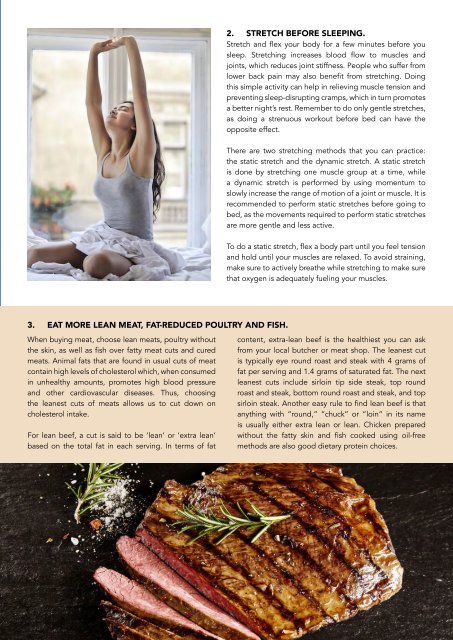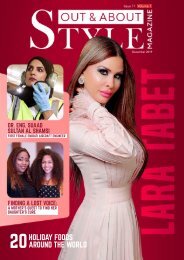Out and About STYLE Mag Issue 3 Vol. 2
Read these articles plus more in Out and About STYLE Mag Issue 3 Vol. 2 Saif and Sound DJ and Radio Presenter Taking Lesson from Mansour Bin Jabr, Emirati Venture Capitalist and Environmentalist Eat for Immunity: A List of Recommended Diets to Boost your Immune System How to Convert Money in Your Mind to Money in The Bank 7 Things You Must Do in Accra, Ghana
Read these articles plus more in Out and About STYLE Mag Issue 3 Vol. 2
Saif and Sound DJ and Radio Presenter
Taking Lesson from Mansour Bin Jabr, Emirati Venture Capitalist and Environmentalist
Eat for Immunity: A List of Recommended Diets to Boost your Immune System
How to Convert Money in Your Mind to Money in The Bank
7 Things You Must Do in Accra, Ghana
You also want an ePaper? Increase the reach of your titles
YUMPU automatically turns print PDFs into web optimized ePapers that Google loves.
2. STRETCH BEFORE SLEEPING.<br />
Stretch <strong>and</strong> flex your body for a few minutes before you<br />
sleep. Stretching increases blood flow to muscles <strong>and</strong><br />
joints, which reduces joint stiffness. People who suffer from<br />
lower back pain may also benefit from stretching. Doing<br />
this simple activity can help in relieving muscle tension <strong>and</strong><br />
preventing sleep-disrupting cramps, which in turn promotes<br />
a better night’s rest. Remember to do only gentle stretches,<br />
as doing a strenuous workout before bed can have the<br />
opposite effect.<br />
There are two stretching methods that you can practice:<br />
the static stretch <strong>and</strong> the dynamic stretch. A static stretch<br />
is done by stretching one muscle group at a time, while<br />
a dynamic stretch is performed by using momentum to<br />
slowly increase the range of motion of a joint or muscle. It is<br />
recommended to perform static stretches before going to<br />
bed, as the movements required to perform static stretches<br />
are more gentle <strong>and</strong> less active.<br />
To do a static stretch, flex a body part until you feel tension<br />
<strong>and</strong> hold until your muscles are relaxed. To avoid straining,<br />
make sure to actively breathe while stretching to make sure<br />
that oxygen is adequately fueling your muscles.<br />
3. EAT MORE LEAN MEAT, FAT-REDUCED POULTRY AND FISH.<br />
When buying meat, choose lean meats, poultry without<br />
the skin, as well as fish over fatty meat cuts <strong>and</strong> cured<br />
meats. Animal fats that are found in usual cuts of meat<br />
contain high levels of cholesterol which, when consumed<br />
in unhealthy amounts, promotes high blood pressure<br />
<strong>and</strong> other cardiovascular diseases. Thus, choosing<br />
the leanest cuts of meats allows us to cut down on<br />
cholesterol intake.<br />
For lean beef, a cut is said to be ‘lean’ or ‘extra lean’<br />
based on the total fat in each serving. In terms of fat<br />
content, extra-lean beef is the healthiest you can ask<br />
from your local butcher or meat shop. The leanest cut<br />
is typically eye round roast <strong>and</strong> steak with 4 grams of<br />
fat per serving <strong>and</strong> 1.4 grams of saturated fat. The next<br />
leanest cuts include sirloin tip side steak, top round<br />
roast <strong>and</strong> steak, bottom round roast <strong>and</strong> steak, <strong>and</strong> top<br />
sirloin steak. Another easy rule to find lean beef is that<br />
anything with “round,” “chuck” or “loin” in its name<br />
is usually either extra lean or lean. Chicken prepared<br />
without the fatty skin <strong>and</strong> fish cooked using oil-free<br />
methods are also good dietary protein choices.<br />
75

















